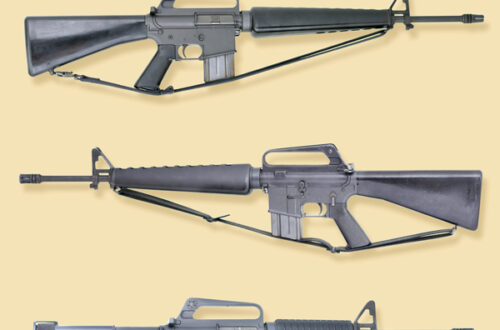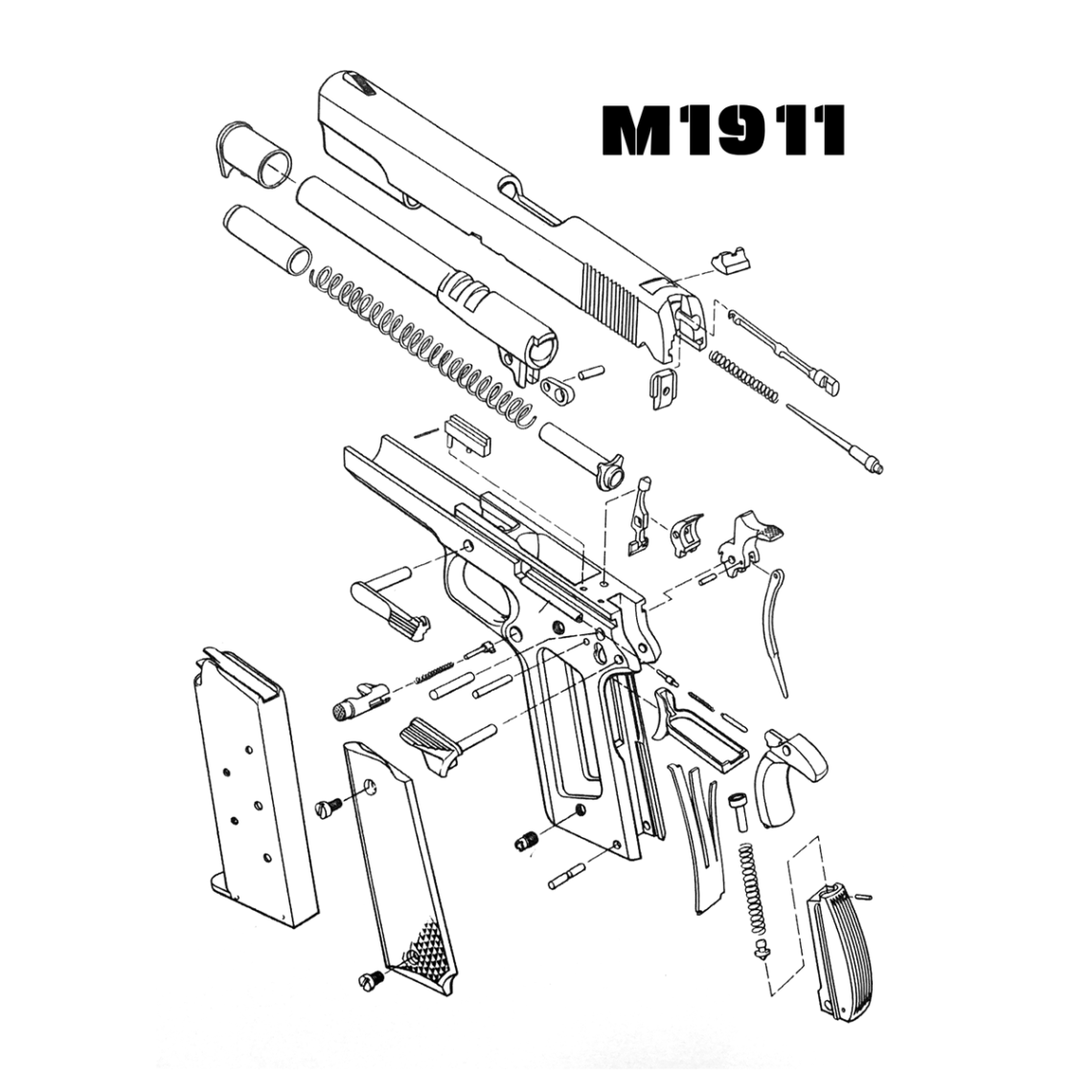-
M14 Complete Owner’s Guide – Table of Contents
Contents CHAPTER 1: READ ME FIRST!…..1 FULL CIRCLE……….1 FULL DISCLOSURE………….1 GROUND RULES and a PET PEEVE……..3 WE WERE NOT ALONE…………..3 CHAPTER 2: A BRIEF HISTORY of the M14……5 PROLOGUE…………5 Imagine It’s December 7, 1941………5 The Genesis of the M14……………….5 Cartridge Development Outside the USA…………..9 Cartridge Development in the USA………..…………11 US Rifle Development………..……….11 From the T20 to the T44 and the M14…….………..13 M14 Design Heritage Summary……….…..17 T44 and M14 Production History………..…..19 Full-Auto Follies………………….19 Changes During Production……….….23 Mel Johnson on the AR-15 versus M14 (GUNS Magazine March 1963)…….24 The Riflemen Leave the Building……….27 “SLAM” Marshall, Hitchman, Hall and Vietnam……..……..29 The M14 Falls Short……………….29 The M14 Hangs On……….…..31 A New War, a New…
-
The M1 Garand: Post WWII – Table of Contents
The purpose of this book is to present accurate information to the collector of the M1 Rifle covering the period from 2 September 1945 through 30 June 1957. The primary subject will be the service grade weapon of this period. The National Match M1, Sniper Rifles, experimental weapons, and the Light Weight Rifle Program will be discussed briefly. Acknowledgements Table of Contents By Walt Kuleck with Drake Oldham CHAPTER 1: The Post War Period – An Overview ……………………………………………. 1 CHAPTER 2: 2 September 1945 – 30 June 1951 – A Time of Change ………………….. 3 CHAPTER 3: 1 July 1951 – 30 June 1953 – The Armory Goes to…
-
The M1 Garand: World War II – Table of Contents
The M1 Garand: World War II is written specifically for the Garand collector. Examined is development and production of the M1 rifle from conception through the closing days of World War II. The first Garands, the Gas Trap rifles, are examined in detail, as are the reasons behind the conversion to a Gas Port system. Data sheets detailing five original Gas Trap rifles are presented. It is full of the history of development and production from 1900 to 1945. INSIDE: Acknowledgements Table of Contents Foreword by David C. Clark Introduction The Man With The Rifle Chapter Page 1900-1936 The Development Years………………………………………………………………………….. 1 1937-1941 The Preparatory Years…………………………………………………………………………….. 17 1942-1945 The War Years………………………………………………………………………………………..…
-
You Can Go Home Again (Part 2)
Have you sold a firearm and almost immediately regretted doing so? If you read my April 2021 Blog post entitled You Can Go Home Again you know that I have. If you haven’t read that post, go ahead and read it, I’ll wait. In the summer of 1976, I was 23 years old, recently married, and thought it was time for me to own a handgun. When I was about 12 years old Dad had taught me firearms safety and how to shoot. But I didn’t know enough about which handgun to choose. After conversations with more experienced friends, I decided I wanted a Smith & Wesson revolver in .38 Special…
-
The M1911 Complete Owner’s Guide – Table of Contents
The M1911 pistol is a single-action, recoil-operated, semi-automatic pistol chambered for the .45 ACP cartridge. The pistol’s formal U.S. military designation as of 1940 was Automatic Pistol, Caliber .45, M1911 for the original model adopted in March 1911, and Automatic Pistol, Caliber .45, M1911A1 for the improved M1911A1 model which entered service in 1926. Designed by John Browning, the M1911 is the best-known of his designs to use the short recoil principle in its basic design. The pistol was widely copied, and this operating system rose to become the preeminent type of the 20th century and of nearly all modern centerfire pistols. It is popular with civilian shooters in competitive events…
-
The M1911 Complete Assembly Guide – Table of Contents
In this book you’ll learn about Pistolsmithing, the M1911 magazines, triggers, stops, locks and history – and much more. Inside: The Model of the 1911 was designed to be a “battle pistol.” The M1911 was adopted by the US Army in 1911 largely on the basis of successfully weathering stringent testing, including environmental testing. These “dust and rust” tests were surmounted by the M1911 despite the metallurgy of the 1910 by providing sufficient clearances for contaminants to be literally “shrugged off.” Thus, while the original M1911s may not have rattle like maracas as legend would have it, they were designed to be loose enough to tolerate dust ‘n rust and…
-
You Can Go Home Again
In June of 1976 I bought my first handgun from Esman’s in Pitcairn, PA. It was a new S&W Model 10 (.38 Special) with blued finish, pencil thin 4-inch barrel and round butt. The price was $113.50. I quickly discovered that I would not shoot it as much as I had planned due to the price of .38 Special ammo being beyond my budget. But I wanted to learn to shoot a handgun and would not be deterred. I had become a regular customer of Export Sporting Goods, having purchased a few long guns from them. They treated me well on prices and allowed me to make payments on layaway…
-
“US Infantry Weapons in Combat – Personal Experiences from World War II and Korea”
When in 1992 I learned that my future father-in-law, Thomas Shoen, Jr., had been a paratrooper in World War II I had to add an M1A1 carbine, jump boots, and a M1942 jump suit to my collection. In conversations with fellow collectors I have found that many of us collect the firearms and accoutrements that we do because our dad, grandfathers, or uncles carried them in World War II or Korea. With that motivation it quickly becomes a personal quest to collect these artifacts as a way to honor their sacrifices for our freedom and in their memory. – Scott Duff Thomas Shoen, Jr. was drafted into the Army in…
-
Sample of United States Rifle Model of 1917
As a serious collector of all U.S. martial arms, I have long awaited publication of a collector-oriented book on the United States Rifle, Model of 1917. Even though the Model 1917 was the predominant rifle of U.S. troops in the “war to end all wars,” it has been largely ignored by collectors. In my opinion, one of the reasons for this neglect is that until now there has not been a book that specifically addresses the type of information that we collectors seek. In order for collector-interest to advance for a particular model of firearm, detailed collector-oriented information must be generally available. Regardless of the model of arm and its…
-
Rock Island Rifle Model 1903
Everyone knows about the famous Springfield ’03. From collectors to service rifle shooters to every 1950s deer camp uncle with a sporterised rifle. But do you know all ‘03s are not Springfields? The M1903 rifle was the primary U.S military rifle from 1903 through 1936 and remained in use in the early days of World War II.































